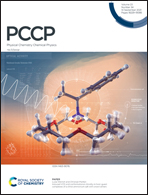Microscopic insights into water adsorption in carbon nanopores – the role of acidic and basic functional groups and their configurations†
Abstract
Functional groups (FGs) in porous carbon play a pivotal role in water adsorption by nucleating water clusters followed by their coalescence, the process in which precursors are used for filling the confined space typically in the reduced pressure range of 0.3–0.8. While the general role of FGs is known, different types of FGs and their configurations are expected to critically affect the formation of clusters and they are yet to be clarified. To this end, we conducted a comprehensive Monte Carlo simulation of water adsorption at 298 K in a functionalized graphitic slit pore as a function of types of FGs (acidic and basic) and their configurations. The adsorption mechanism is derived from the analysis of adsorption/desorption isotherms, isosteric heat, and 2D density and compressibility distributions. Our results show that (1) with the increasing density of FGs, the isotherm switches from Type V to Type I and the precursor used for pore filling shifts from clustering to molecular layering, (2) the intra-rotation of atoms around the Sigma bonds in the FGs plays an important role in clustering when the FGs are in proximity and (3) for a given density of FGs, the configurations (interspacing distribution) of FGs dictate the shape and size of the water clusters, affecting the filling and emptying of water molecules from the confined space, which have practical implications in moisture control by solid adsorbents.

- This article is part of the themed collection: 2021 PCCP HOT Articles


 Please wait while we load your content...
Please wait while we load your content...